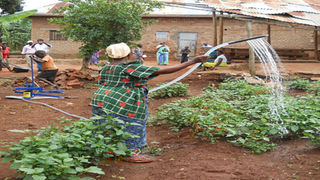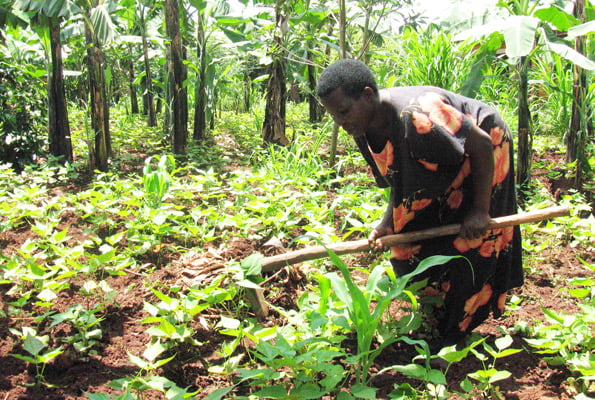
Farmers can build and install dam-liners, water tanks and sand dams during the rainy season to collect enough water to irrigate their farms and water their livestock when the dry spell approaches. PHOTO/NMG
|Farming
Prime
Some approaches to the current pressing agricultural challenges
What you need to know:
- Innovation: Some approaches to the current pressing agricultural challenges.
Agriculture today faces a number of pressing issues mainly as a result of climate change.
It is no longer easy for farmers to predict when the rains will be starting or ending as used to be the case before.
Unpredictable rains
The weather patterns have become so unpredictable and yet for such a long time, as has been mentioned by P.J. M. Cooper, R. Coe, and R D Stern in their book, Experimental Agriculture, rain-fed agriculture in sub-Saharan Africa has been the mainstay of the continent’s food and feed production.
“Nearly 90 percent of staple food and feed production comes from, and will continue to come from rain-fed agriculture,” the authors say.
The growing weather unpredictability which is marked by long droughts and devastating floods, in some areas, calls for increased investment in the agricultural production system.
Harvesting rainwater
Farmers must be given skills in rainwater harvesting and conservation and more effort ought to be devoted to irrigation. Dr David Mukasa Bulonge, country representative of a local farming five-year- project, spearheaded by Jenny Flathen Taylor Foundation (JFT-Foundation) told Seeds of Gold, “We need to think more about how our farmers can continue with production even when there is no rain for long periods.
More investment must be put in construction of large water tanks and subsidising the cost of all rainwater collection and storing gadgets such as plastic tanks and irrigation equipment.” He mentioned a large water tank he has seen at Sanje Farming School in Kyotera District which has capacity to store half a million litres of rainwater.
How to trap rainwater
Bulonge says the rainwater is trapped from all the roofs of the buildings at the farm school and stored in the huge reservoir.
The water is then pumped into another tank raised a few metres above the ground from where it flows by gravity to wherever it is needed on the school farm when the rains fail.
Bulonge also mentioned another huge rainwater tank constructed at St Jude Agricultural Institute Busense in Masaka District with capacity to store 250,000 litres of water.
Bulonge says that such large tanks would be helpful in many farming communities and that farmers’ groups should be encouraged to consider constructing them even if it would involve taking bank loans.
“Extension service providers should be empowered to go all over the country helping farmers with putting up more rainwater conservation technologies,” he says.
When stored water is available on the farm during the dry season, livestock can drink it and it can be used for some simple irrigation of the crops.
Training farmers
Dr Nicholas Ssekabunga, farm manager of Mbarara Zonal Agricultural Research and Development Institute (MuZARDI), says; “Today’s farmer in Uganda is not sure when the rains will begin and very often there is no pasture for the animals. These are all manifestations of climate change. Therefore, we are encouraging farmers to store their own feeds for their livestock during those days when there is no rain.”
He says that at MuZARDI farmers are taught to make hay and silage which can be used to feed livestock during times of scarcity.

He goes on to reveal that a research has been conducted at his institute about the best material for making silage and it has been found that a particular maize variety, locally known as ‘fortunate’ and a certain type of napier grass are the best for silage making.
“We advise all farmers to visit the agricultural research institutes in their respective areas to get free information and education on how to make hay and silage,” says Ssekabunga. “They can come to MuZARDI, or Kamenyamiggo in Lwengo District and to several others across the country, about 16 of them, including Arua and Karamoja,” he says.
Climate change
Along with unpredictable extreme weather events, climate change has come with the eruption of hitherto unknown dangerous pests such as the Black Coffee Twig Borer, the fall armyworm, among others. According to the National Coffee Research Institute (NaCORI) the Black Coffee Twig Borer is present in nearly all coffee growing areas of Uganda and causes up to 10 percent loss of national coffee output valued at $40m per annum. The African fall armyworm is present in more than 30 districts in Uganda and is killing off entire fields of maize, sorghum, millet, and even pasture.
At present one of the most considered solutions to the problem is the use of pesticides which are however a growing threat to biodiversity, public health, and the environment. A study conducted in 2018 by Pesticide, Health, and Environment (PHE) project revealed that 94.2 percent of all water sources in Uganda had detectable concentrations of a pesticide residue which was attributed to gross mishandling of pesticides by farmers.
Aggrey Atuhaire who is in charge of the Pesticide Safety Programme under Uganda National Association of Community and Occupational Health (UNACOH) told Seeds of Gold, “With the arrival of climate change, we cannot easily run away from using agricultural chemicals. Yet our farmers lack the necessary guidance and education on pesticide usage which presents a big health risk. Government should put in place spray service provider teams with proper equipment and skills to do the spraying of pesticides in affected areas almost like we have village health teams everywhere.”
He says teams of that kind should be up scaled and made available in every village to ensure safe usage of pesticides and removal and disposal of empty containers.
He says they can be sustained by a befitting service fee paid by the farmers.
Pesticides
The World Health Organisation (WHO) has approved a list of pesticides for controlling the African armyworm which include Amdocs, Rocket, Agro-cypro, Profenofos, Hitchell, Profecron, Sucket, Olus, Cypercal, Striker, Engeo, Chlobenzo, Prove (EC), and Dynamo (WG).
The Black Coffee Twig Borer is fought mechanically by plucking off dead twigs and burning them but in case of heavy infestation, NaCORI advises the use of 60 mills of the agri-chemical, imidacloprid (IMAX), mixed with 90 mills of tebuconazole (ORIUS) in a 15-litre sprayer to spray 60 trees.
The delay by the government to have a biotechnology and bio-safety regulatory law in place has not helped matters since the farmers must only depend on pesticides and mechanical ways to deal with pests.

In many other African countries such as Kenya, Ethiopia, Sudan, Nigeria, Burkina Faso, Mozambique, South Africa, and Egypt among others biotechnology is relied upon in combination with conventional breeding to develop improved crop varieties that can withstand pests and tolerate drought without recourse to pesticides.
Key facts
What should a farmer have in place to start harvesting rain water and how does one go about it? Before harvesting any rainwater, a farmer needs to estimate the area’s rainfall potential.
The rainfall potential is the surface area one has available to collect water from (typically a roof) multiplied by the annual rainfall received in that area. For instance, the rainfall potential of a roof 100 m2 in an area that receives 1,000mm of rain per year is 100m3.
One also needs to determine the right amount of storage for it. This is based on how you intend to use the water.
Besides irrigating your crops, a farmer may use the harvested water for washing the car, flushing the toilet and, if well treated, it can be used for drinking and cooking.




